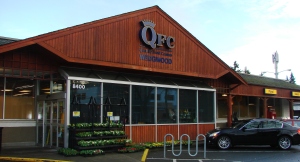
There has been a grocery store at the corner of NE 85th Street in Wedgwood since 1959, first Tradewell, then Matthew’s Red Apple, then QFC. The QFC closed in April 2021 and redevelopment of the site is pending.
The intersection of NE 85th Street on 35th Avenue NE is the heart of the Wedgwood neighborhood and is its main commercial center.
Today it is difficult to imagine that any corner of this intersection would be vacant, and yet the site had no buildings on it until 1959.
Up until 1959 when the Tradewell grocery was built, the vacant corner property had a long ownership by people who seemed to be just holding it as an investment and did not come to live in Wedgwood themselves.
Copyright notice: text and photos on this article are protected under a Creative Commons Copyright. Do not copy without permission.
In the early 1900s the present site of the (now-closed) Wedgwood QFC building, at NE 85th Street, was vacant land owned by George Naden, who worked for the Surveyor General of the State of Washington. In the course of his career Naden moved from Seattle to Olympia and worked in the state office there. Mr. Naden’s wife died in 1910, leaving him with one young son still at home. Mr. Naden remarried ten months later, in August 1911, and began the work of building a new house in Olympia.
Perhaps because of his desire to shed his old life and start a new life with a new wife and a new house, in June 1911 Mr. Naden sold his property in Seattle. The purchaser was Walter S. Fulton, a prominent attorney. It is probable that the two men knew each other either through work associations or from one of the men’s clubs that each belonged to in Seattle, such as the Fraternal Order of Eagles, the Rainier Club or the Seattle Golf and Country Club.
From Yesler to Yesler
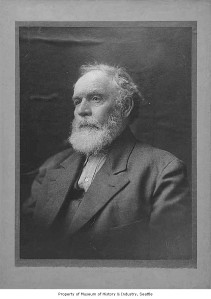
W. H. “Joe” Surber, undated photo courtesy of MOHAI, Item 1957.12847
One of the earliest residents of northeast Seattle was William H. Surber, who was born in Indiana. In 1857 at age 22 Surber joined a wagon train departing from Missouri out to California. On the expedition he soon demonstrated the skill with a rifle which he employed throughout his life. He was appointed official hunter for the wagon train company, supplying them with the meat of prairie chickens, antelope and even buffalo.
Surber prospected in California and in Fraser River, Canada, before his arrival in Seattle in the spring of 1859, according to the account of him written by early Seattle real estate man C.T. Conover. In those early days there was so much work at Henry Yesler’s downtown Seattle waterfront sawmill, that they could hardly find enough men to do it. Anyone who stepped off a boat onto the dock could find a job, and Surber began work at the mill on the day he came to Seattle. He never did say what his name was and that is how he acquired the nickname “Joe,” as in “hey, Joe.” In later years he was always referred to as Uncle Joe.
Surber immediately began to supplement his sawmill wages with the use of his rifle. Arthur Denny, one of Seattle’s founders, had a meat market and Joe Surber would supply him. In those days the tree line was still close, along the present Third Avenue in downtown. In his first week in Seattle Surber shot a deer at Third and Marion Streets near what is now the Wells Fargo Bank.
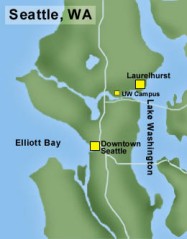
Map courtesy of HistoryLink
Surber saved his money and began to buy heavy construction equipment (brought by ship from San Francisco.) He became a contractor who helped drive piles for J.M. Colman’s wharves at the Seattle waterfront and for railroad trestles. But he always kept up his shooting skill and perhaps because of it, he was appointed King County’s first sheriff in 1866.
In 1861 Surber filed a homestead claim on land which he said he had chosen because it was his favorite hunting ground. His land claim later became part of Laurelhurst, with the western edge of his property along Surber Drive south of NE 45th Street and fronting on Union Bay, a part of freshwater Lake Washington. The Lake Washington Ship Canal had not yet been built and Union Bay was a quiet lagoon which teemed with birds.
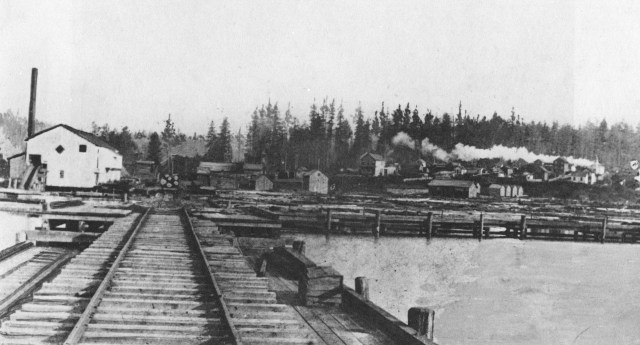
Looking north from Union Bay, we see the sawmill with the Town of Yesler on the hillside which would later become Laurelhurst. Photo courtesy of the Seattle Public Library.
By 1888 Uncle Joe was in his mid-fifties and ready to scale back from the hard work on docks and railroad trestles. Territorial census records show that he went to live permanently on his claim site at Union Bay. Two of his nieces, Alice and Clara Shelton, came out from Indiana and kept house for him.
At that same time Surber’s long-time associate Henry Yesler was looking for a new site for a sawmill. A sawmill needed to be located close to the supply of trees and its industrial process was water-dependent. Yesler and his investor J.D. Lowman, who ran Yesler’s businesses, bought the western half of Joe Surber’s property, platted it in 1888 as the Town of Yesler, and set up a sawmill. Surber had started out his life in Seattle working at Yesler’s downtown sawmill and it seemed he went from Yesler to Yesler – the sawmill followed Surber out to Union Bay.
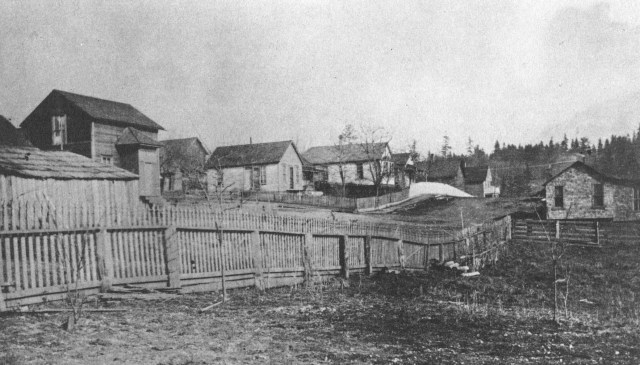
The Town of Yesler circa 1902, looking east along NE 42nd Street. Photo courtesy of History of Laurelhurst by Christine Barrett.
The boundaries of the Town of Yesler plat were from Front Street at the shoreline of Union Bay (NE 41st Street) to Railroad (NE 45th Street) and from Surber Drive (35th Ave NE) to 38th Ave NE.
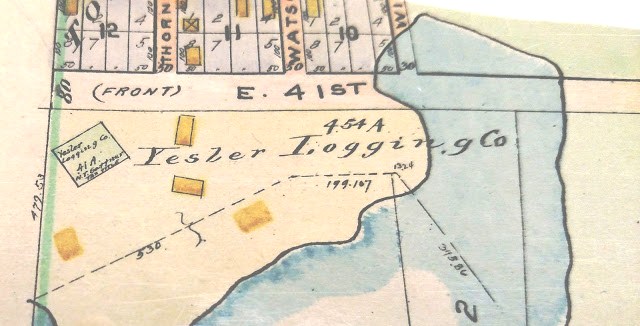
Site of the Yesler Mill is now the Center for Urban Horticulture in Laurelhurst. The water came up higher than at present, because as of the 1911-1917 Lake Washington Ship Canal project, the water level was lowered. Source: Baist map of 1908.
The site of the Town of Yesler sawmill was approximately at the present Center for Urban Horticulture at 3501 NE 41st Street. Old pilings for the sawmill’s docks can still be seen just offshore from the Yesler Swamp Trail-Union Bay Natural Area. The Seattle, Lake Shore & Eastern Railroad had reached Union Bay by 1887, so it was an ideal site for the Town of Yesler to be able to receive goods and send out lumber via rail.
As the owner of what had become a “country estate” at Yesler/Laurelhurst, in later years of his life Uncle Joe Surber liked to entertain friends who would go hunting with him. He kept a supply of guns and ammunition with a gun designated permanently to each person’s use. One of Uncle Joe’s surprising friendships was with Walter S. Fulton, his hunting buddy who was almost forty years younger than Joe.
Growing up in pioneer Seattle
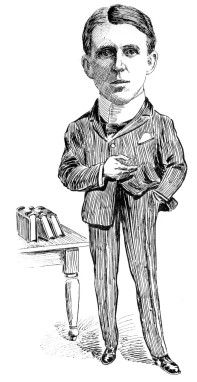
Walter Fulton as portrayed by Argus magazine of 1906.
Walter S. Fulton had an unusual upbringing in that even though both of his parents were still living, in 1881 at the age of eight he was sent out to Seattle to live with his uncle. Walter’s uncle was not just “anybody;” he was Judge William H. White, justice of the Supreme Court of Washington. Judge White saw to it that his nephew was educated all the way through the University of Washington and then sent him on to take a law degree at the University of Michigan.
At age 21 in 1894, Walter Fulton returned to Seattle and began the practice of law. After about six years of working in his uncle’s law office of White & Munday, Fulton became Prosecuting Attorney of King County, where he was the youngest ever to serve in that office, and he served with distinction. After one term he returned to private practice and did a lot of prominent trial work. (Argus magazine’s cartoon version of Walter Fulton, circa 1906, is at right.)
Friends and hunting partners in old Seattle
Uncle Joe Surber was a client of attorney Walter Fulton’s but they were also friends, with a rifle specially reserved for Fulton’s use on hunting expeditions. Despite the big age gap between them, Surber esteemed Fulton as one of the pioneers, defined as anyone who had lived in Seattle before the Great Fire of June 6, 1889. The Fire had completely obliterated not only the infrastructure but also the old social order of Seattle. After the Fire, floods of newcomers changed the status quo in Seattle, so in later years of his life Uncle Joe seemed to gather friends from the old days around him. He trusted Walter Fulton and made Fulton executor of his estate.
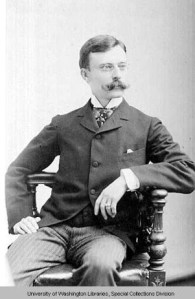
Charles T. Conover (1862-1961) was an early newspaper writer and real estate developer in Seattle.
In early Seattle no one, not even judges or attorneys, was above swinging a tool or shooting a gun. Judge White was a gun-and-hunt-club enthusiast so it is likely that he taught his nephew the basics of marksmanship. It may have been Joe Surber who taught Walter Fulton outdoorsman skills such as tracking animals, building a shelter in the woods and starting a campfire. In the biographical article about Uncle Joe written by early Seattle real estate man C.T. Conover, Fulton earned mention as Surber’s friend, attorney and hunting partner.
Property records show that well past the year 1900 the Wedgwood area had almost no people living in it, and Wedgwood was likely one of Surber’s hunting grounds. Even today Wedgwood’s Maple Creek Ravine has deer, coyotes and raccoons. We know that Surber continued hunting into the twentieth century and he supplied meat for the Town of Yesler which had sprung up around the sawmill on Union Bay next to Surber’s estate.
We can imagine Uncle Joe and Walter Fulton hiking from Union Bay up 35th Ave NE which was then a dirt path. At NE 85th Street they would turn northeast to get to the heavily wooded ravines of Wedgwood where there was game to be bagged. This may be when Walter Fulton first looked over the property which was owned by George Naden at the corner of NE 85th Street.
Fulton’s investment in unoccupied northeast Seattle
As an attorney with skills in evaluating information, Walter Fulton certainly would have known that the property he bought from George Naden in 1911 was located at a future intersection, and that it was likely to become a major intersection. Seattle’s land survey of 1855 had marked out section lines and there were major streets indicated at about ten-block intervals. That is the foundation of our present street system with cross-streets at NE 75th, NE 85th, and so on. These streets existed only on the survey map, however, and were not actually put through for many years.
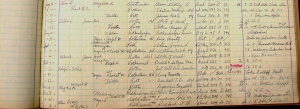
This 1942 sales transaction index shows that on Oct. 7 Ralph H. Rothermel sold land to Balch. Original record book stored at the Puget Sound Regional Archives, Bellevue, WA.
Walter Fulton held onto his 1911 land purchase at NE 85th Street, perhaps waiting for the property value to rise as the area became more populated. Walter Fulton died in 1924 and his wife Etta died in 1938, and yet property records show that their estate, represented by Etta’s mother Emma Nugent, continued to own the land at the corner of 35th Ave NE and NE 85th Street.
Finally in 1941 Mrs. Nugent sold the land. The new owner, Ralph H. Rothermel, held the property only eighteen months, and then sold it in October 1942 to Albert Balch, developer of Wedgwood. Wedgwood had not yet become the neighborhood name as of 1942 but the area was about to be transformed by Balch’s energetic building program.
Wedgwood’s shopping center
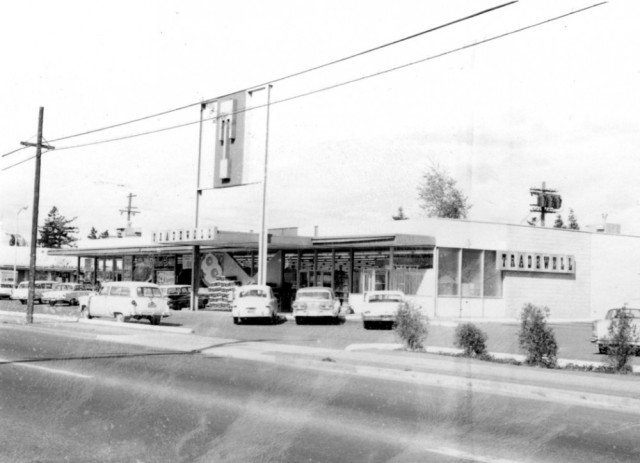
The Tradewell Grocery Store as pictured in 1962, was built in 1959 and is the present site of QFC at 8400 35th Ave NE. Photo courtesy of Seattle Municipal Archives image 76718.
Balch knew that the intersection of 35th Ave NE at NE 85th Street was ideal for commercial development, as it was the center of the neighborhood. Balch’s first, original Wedgwood houses were directly across the street on the west side of 35th Ave NE. A shopping center at NE 85th Street would be very convenient for the new Wedgwood homeowners.
Balch was a builder of residential housing but he wanted to complete the neighborhood fabric by providing a central place for stores and for services such as medical offices and restaurants. He held the NE 85th Street southeast corner site for later commercial development.
During the busy growth years of the 1940s and 1950s Balch used the property at NE 85th Street as a staging area for his construction projects, a place to store lumber and equipment as he built houses in Wedgwood. The vacant lot even became the starting-place for Christmas tree sales in Wedgwood, as Balch allowed the Hunter family to set up there.
Balch leased the NE 85th Street site to commercial entities such as the Tradewell grocery store built in 1959. Later, Balch helped start a restaurant next to the grocery which was at first called Sir Wedgwood.

The center of the Wedgwood business district is at the intersection of NE 85th Street where there is a (closed) QFC grocery store. The other stores are still open: the Wedgwood Broiler restaurant and other stores and banks. Photo by Valarie.
Much later, other buildings, including the present row of storefronts and Homestreet Bank were built. All of the property from NE 82nd to NE 85th Streets, from Homestreet Bank to the grocery store building, is one parcel. It is the largest parcel in Wedgwood at more than two acres.
Next time you visit the stores or banks in Wedgwood’s shopping district at the intersection of 35th Ave NE and NE 85th Street, out of the corner of your eye you may catch sight of two men: one, eighty years old and a little slow of step but still quick-eyed; the other man, age forty, in the prime of life with ramrod-straight posture and the presence and bearing of a successful trial attorney. You have just caught an imaginative glimpse of Uncle Joe Surber and his hunting buddy, Walter Fulton, who stalked game in the woods of Wedgwood in early days.
Sources:
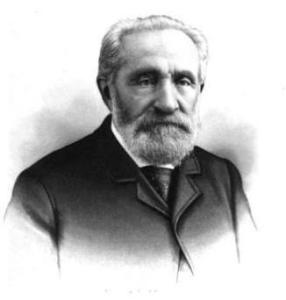
Henry Yesler (1810?-1892) His sawmill on the downtown waterfront was the economic engine of early Seattle.
A History of Laurelhurst, Christine Barrett, 1981.
Grantor-Grantee index, King County property sales 1911; 1941-1943. Puget Sound Regional Archives at Bellevue University, Bellevue, WA. Accessed January 9, 2013.
HistoryLink Essay #3345: Laurelhurst Thumbnail History by Junius Rochester, 2001.
HistoryLink Essay #10182: Union Bay Natural Area by John Caldbick 2013. This essay traces the site from the time of the Montlake garbage dump.
Jon Jarvis: Mr. Jarvis shared his memories of Wedgwood of the 1940s and 1950s. He described the present QFC & shopping center site which was vacant until the first grocery store building (Tradewell) in 1959.
“Mill Village: Yesler on Union Bay,” history article by Eleanor Boba, May 2016.
Men Behind the Seattle Spirit: The Argus Cartoons. H.A. Chadwick, editor, 1906. Seattle Room RB.0 Ar38M, Seattle Public Library.
Paul Dorpat: See his article of December 14, 2013, for more views of the Town of Yesler and the University Village area.
Rob Ketcherside: A Seattle historian, Mr. Ketcherside has done extensive research on the history of Tradewell stores. For more about Tradewell in Wedgwood and other grocery stores in the Wedgwood neighborhood, see my article called Groceries and Growth.
“Uncle Joe Surber, Mighty Hunter.” Mirrors of Seattle by C.T. Conover, 1923. Seattle Room RB. C763M, Seattle Public Library.
Union Bay Natural Area — the Yesler sawmill was at the present site of the Center for Urban Horticulture building, 3501 NE 41st Street. On one side of the parking lot is the Yesler Swamp Trail which leads to the water’s edge.
“Walter S. Fulton.” History of King County, by Clarence Bagley, 1926. Vol. 3, p. 424-428. Seattle Room, Seattle Public Library.

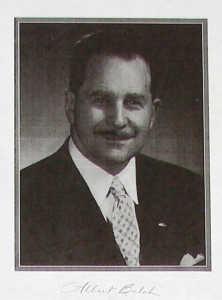
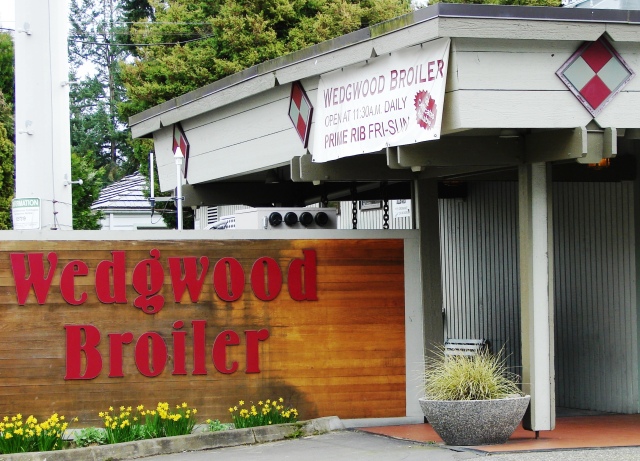
Valarie, do you happen to know exactly where the depot for Yesler Junction was located?
Eleanor, the volunteers of the Yesler Swamp Trail checked the property tax assessment rolls (see footnote number 30 on their history article) and found the Yesler Station at about 30th Ave NE behind what is now University Village, which was a log pond at that time. There was a spur to the railroad which ran all the way down to the mill at the present site of the Center for Urban Horticulture.
See also my article on this blog about the Keith Station which was the next one, on the present site of Metropolitan Market next to the Trail. Author David B. Williams took the photo of the map with “Keith” marked on it and it was actually Mr. Williams who started both of us on the quest to find the reasons for the names of stations on the SLS&E Railroad.
Thanks. This is very helpful!
The Yesler Swamp People are awesome and I am looking forward to some more of their tours and celebrations this year.
Pingback: Surber Drive NE ~ Writes of Way